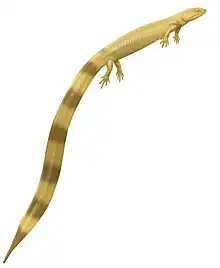Pariotichus
Pariotichus is an extinct genus of gymnarthrid microsaurs from the early Permian of Texas.
| Pariotichus | |
|---|---|
| Scientific classification | |
| Domain: | Eukaryota |
| Kingdom: | Animalia |
| Phylum: | Chordata |
| Subclass: | †Lepospondyli |
| Order: | †Microsauria |
| Family: | †Gymnarthridae |
| Genus: | †Pariotichus Cope, 1878 |
History of study
Pariotichus was collected by Jacob Boll from the Wichita Group of Texas in 1878 and described by American paleontologist Edward Drinker Cope in the same year. It is one of the first 'microsaurs' to be described from North America.[1] The type species is Pariotichus brachyops, which remains the only presently recognized species of the genus. Other species of Pariotichus were described, mostly by Cope, that have subsequently been identified as captorhinomorph reptiles (including the well-known Captorhinus aguti) and were reassigned by Case (1911).[2] One other species, "Pariotichus megalops" is a junior synonym of the dvinosaur temnospondyl Isodectes obtusus.[3] The osteology and relationships of P. brachyops were subsequently reviewed by Gregory et al. (1956) and Carroll & Gaskill (1978).[4][5]
Anatomy
The holotype and only specimen of Pariotichus is a partial skull currently reposited at the American Museum of Natural History. The relatively poor preservation has complicated attempts to properly characterize its anatomy relative to other early Permian gymnarthrids from Texas, particularly the smaller Cardiocephalus and the larger Euryodus. General attributes of the skull such as proportions and dental morphology conform to those of other gymnarthrids. The most recent revision by Carroll & Gaskill (1978) did not present a diagnosis for the genus or species. The stratigraphic occurrence in the Wichita Group precedes that of Cardiocephalus and Euryodus in the Clear Fork Group.
Relationships
Pariotichus has rarely been included in phylogenetic analyses but is usually recovered as a gymnarthrid.[6] Below are the results of the analysis by Huttenlocker et al. (2013):[7]
| ||||||||||||||||||||||||||||||||||||||||||||||||||||||||||||||||||||||||||||||||||||||||||||||||||||||||||||||||||||||||||||
References
- Cope, E. D. (1878). "Descriptions of Extinct Batrachia and Reptilia from the Permian Formation of Texas". Proceedings of the American Philosophical Society. 17 (101): 505–530. ISSN 0003-049X. JSTOR 982652.
- Case, Ermine Cowles (1911). A revision of the Cotylosauria of North America. Washington, D.C.: Carnegie Institution of Washington. pp. 1–145. doi:10.5962/bhl.title.45604.
- Sequeira, Sandra E.K. (1998). "The cranial morphology and taxonomy of the saurerpetontid Isodectes obtusus comb. nov. (Amphibia: Temnospondyli) from the Lower Permian of Texas". Zoological Journal of the Linnean Society. 122 (1–2): 237–259. doi:10.1111/j.1096-3642.1998.tb02531.x. ISSN 0024-4082.
- Gregory, Joseph T; Peabody, Frank E.; Price, Llewellyn I. (1956). "Revision of the Gymnarthridae, American Permian microsaurs". Peabody Museum of Natural History Bulletin. 10: 1–77.
- Carroll, Robert L.; Gaskill, Pamela (1978). The order Microsauria. American Philosophical Society. pp. 1–126. OCLC 654168566.
- Ruta, Marcello; Jeffery, Jonathan E.; Coates, Michael I. (2003-12-07). "A supertree of early tetrapods". Proceedings of the Royal Society of London. Series B: Biological Sciences. 270 (1532): 2507–2516. doi:10.1098/rspb.2003.2524. ISSN 1471-2954. PMC 1691537. PMID 14667343.
- Huttenlocker, Adam K.; Pardo, Jason D.; Small, Bryan J.; Anderson, Jason S. (2013). "Cranial morphology of recumbirostrans (Lepospondyli) from the Permian of Kansas and Nebraska, and early morphological evolution inferred by micro-computed tomography". Journal of Vertebrate Paleontology. 33 (3): 540–552. doi:10.1080/02724634.2013.728998. ISSN 0272-4634.



